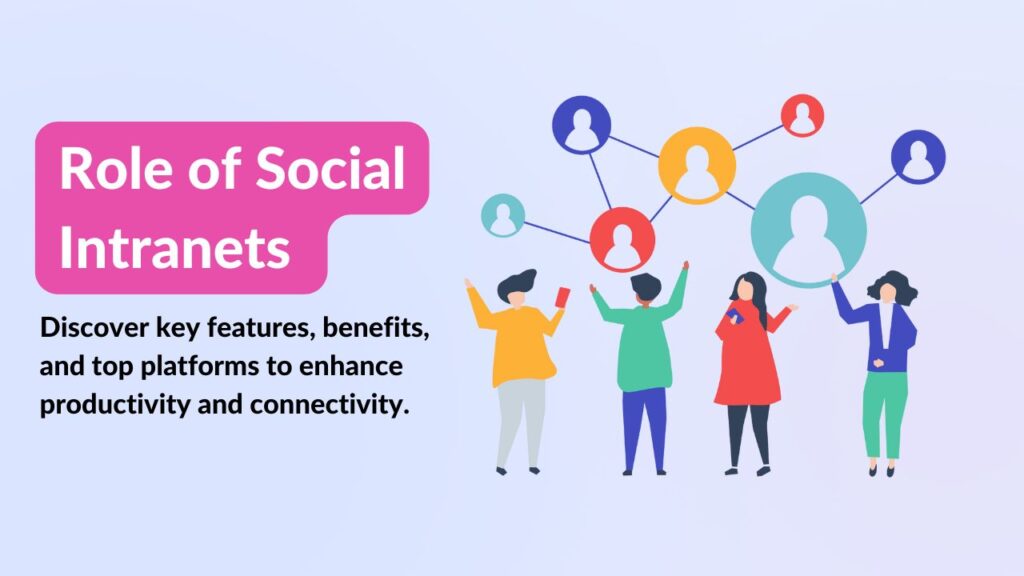
Seamless collaboration and communication are crucial for success in today’s fast-paced work environment. Social intranets are digital platforms designed to streamline workflows, enhance employee connectivity, and foster a sense of community within organizations. Unlike traditional intranet systems, social intranets incorporate interactive features such as forums, real-time chats, and collaborative tools, making social intranet communication more engaging and dynamic.
The primary goal of a social intranet is to create a centralized space where employees can access resources, share ideas, and work together efficiently. As remote and hybrid work setups become the norm, these platforms are instrumental in addressing the challenges of dispersed teams. By acting as a virtual hub, social intranets promote transparency, inclusivity, and collaboration, leading to improved productivity and stronger workplace engagement.
For organizations striving to drive innovation and maintain a competitive edge, investing in a robust social intranet is a strategic move. This guide explores the benefits, use cases, and top social intranet platforms to consider.
A social intranet is a modern digital platform designed to enhance collaboration, communication, and employee engagement within an organization. Unlike traditional intranets that primarily function as static information repositories, social intranets integrate interactive social features, creating a dynamic and engaging environment for employees.
Social intranets combine conventional intranet functionalities with interactive tools such as:
Companies that adopt social intranets experience tangible benefits. For example:
Social intranets significantly improve internal communication by providing employees with real-time updates, company news, and team announcements. By integrating discussion forums, instant messaging, and chat functionalities, these platforms eliminate communication barriers and ensure that employees stay informed, no matter their department or location.
By offering a centralized space for teamwork, social intranets enable employees to collaborate seamlessly on projects. Task management, document sharing, and real-time communication tools reduce redundancy, increase efficiency, and allow cross-functional teams to work together effectively.
Social intranets help keep employees engaged by creating opportunities for interaction, recognition, and feedback. Features like internal social media feeds, polls, and recognition programs foster a sense of belonging, boosting job satisfaction, productivity, and retention rates.
By integrating various tools and workflows into a single platform, social intranets simplify everyday processes. Employees can quickly access documents, track project milestones, and communicate with colleagues without switching between multiple platforms, allowing them to focus on core responsibilities.
Social intranets create a knowledge-sharing culture by providing employees with access to expertise, best practices, and valuable insights. Through discussion threads, expert forums, and content libraries, organizations can ensure that institutional knowledge is easily accessible, fostering continuous learning and innovation.
With remote and hybrid work becoming more prevalent, maintaining effective collaboration and communication can be challenging. Social intranets serve as a centralized platform where employees can connect, share information, and participate in virtual meetings. Features like instant messaging and video conferencing bridge the gap between remote team members, enhancing engagement and productivity.
A social intranet is a valuable tool for streamlining the onboarding process. New hires can access essential company documents, training materials, and orientation resources all in one place. Discussion forums and internal messaging allow them to connect with team members, ask questions, and integrate seamlessly into the company culture from day one.
Social intranets facilitate efficient project management by enabling teams to collaborate using shared calendars, task management tools, and real-time document collaboration. These platforms help align team members with responsibilities and deadlines, reducing miscommunication and ensuring smoother project execution.
Industry: Healthcare
Intranet Platform: theEMPLOYEEapp
Key Features & Impact:
Industry: Retail & Hospitality
Intranet Platform: Workplace from Meta
Key Features & Impact:
Industry: Beverage
Intranet Platform: Jive
Key Features & Impact:
Industry: Food & Beverage
Intranet Platform: Microsoft SharePoint
Key Features & Impact:
Industry: Telecommunications
Intranet Platform: LumApps
Key Features & Impact:
Industry: Consumer Goods
Intranet Platform: Yammer (Microsoft 365)
Key Features & Impact:
Industry: Hospitality
Intranet Platform: Staffbase
Key Features & Impact:
Industry: Electronics
Intranet Platform: Igloo
Key Features & Impact:
Industry: Transportation
Intranet Platform: Interact
Key Features & Impact:
Industry: Beverage
Intranet Platform: Happeo
Key Features & Impact:
Social intranets are transforming workplaces by fostering collaboration, improving communication, and increasing employee engagement. From streamlining workflows to supporting remote teams, these platforms offer comprehensive solutions tailored to modern organizational needs. Investing in the right social intranet ensures seamless integration, enhances productivity, and helps organizations stay connected in an increasingly digital world.
1. How do social intranets improve employee engagement?
Social intranets enhance engagement by facilitating collaboration, recognizing employee achievements, fostering a sense of community, and enabling real-time feedback.
2. Can small businesses benefit from social intranets?
Absolutely! Small businesses can leverage social intranets to streamline processes, enhance communication, and foster employee engagement, leading to a more connected workforce.
3. Are social intranets secure for sharing sensitive information?
Yes, social intranets offer robust security features, including encryption, access controls, and user authentication, ensuring sensitive information remains protected.
4. What industries benefit the most from social intranets?
Industries such as IT, healthcare, education, finance, and retail gain the most from social intranets due to improved communication, collaboration, and knowledge-sharing capabilities.